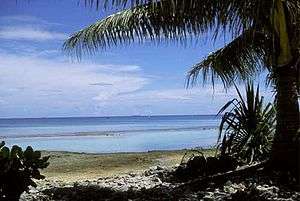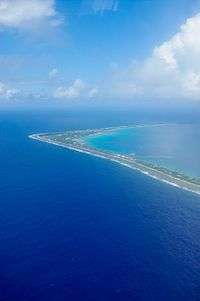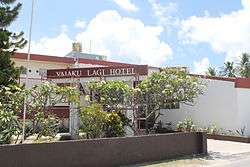Fongafale
Fongafale (also spelled Fogale or Fagafale) is the largest of Funafuti's islets in Tuvalu.[1][2] It is a long narrow sliver of land, 12 kilometres long and between 10 and 400 metres wide, with the South Pacific Ocean and reef on the east and the protected lagoon on the west. The north part is the Tengako peninsula and Funafuti International Airport runs from northeast to southwest on the widest part of the island with the village and administrative centre of Vaiaku on the lagoon side.[3][4] On Fongafale, the Funafuti Kaupule is responsible for approval of the construction of houses or extensions to an existing buildings on private land and the Lands Management Committee is the responsible authority in relation to lands leased by Government.[5]
Fongafale | |
|---|---|
Island | |
Location of Fongafale island in the Funafuti atoll | |
 Fongafale Location in Tuvalu | |
| Coordinates: 08°31′S 179°12′E | |
| Country | Tuvalu |
| Atoll | Funafuti |
In 1972 Funafuti was in the path of Cyclone Bebe. Cyclone Bebe knocked down 90% of the houses and trees on Fongafale. The storm surge created a wall of coral rubble along the ocean side of Fongafale and Funafala that was about 10 miles (16 km) long, and about 10 feet (3.0 m) to 20 feet (6.1 m) thick at the bottom.[6][7]
Villages on Fongafale
There are four neighbourhoods (officially villages, which appear as one contiguous urban area):
- Alapi
- Fakai Fou
- Senala
- Vaiaku
Vaiaku is the most important, most southern and most western neighbourhood, which includes the Vaiaku Lagi Hotel (the only hotel of the country, there are also a few guesthouses), some shops, a fuelpump station, the general post office and the National Bank of Tuvalu, which is Tuvalu's only commercial bank.[3] The villages have a surface area of more than 0.65 square kilometres and approximately 4,000 inhabitants.
Parliament of Tuvalu and government buildings

The Parliament of Tuvalu or Palamene o Tuvalu and the house of the Governor General of Tuvalu are located on Fongafale . The buildings located on Fongafale include the offices of the government ministries and the government agencies such as the Tuvalu Philatelic Bureau, the Tuvalu Meteorological Service, the National Bank of Tuvalu, the offices of the Tuvalu Telecommunications Corporation and the Tuvalu National Library and Archives.[3] The Tuvalu Media Department, which operates radio services as Radio Tuvalu, is also locate on Fongafale.
The police service has its headquarters on Fongafale. The High Court of Tuvalu is also located on Fongafale, as well as the jail. The Princess Margaret Hospital, which is the only hospital in Tuvalu, is located on Fongafale.[3] Other significant buildings located on Fongafale are the co-operative shop, Tausoa Maneapa (community hall) and Fetu Ao Lima (Morning Star Church) of the Church of Tuvalu.

Transportation
Air
Tuvalu's only airport, Funafuti International Airport, is located here.[3] All connections are to Suva, Fiji via Fiji Airways.
Land
There are four taxis, and motorbikes are available for hire.
Water
Access to the Funafuti Conservation Area is by boat; the Conservation Area is 15 kilometres (9.3 mi) across the lagoon from the main island of Fongafale.
There are port facilities on Fongafale. There are two passenger/cargo ships, Nivaga II and Manu Folau, which provide round trip visits to the outer islands every three or four weeks and which also travel between Suva, Fiji[8] and Funafuti 3 to 4 times a year.
Aquifer salinization of Fongafale
The investigation of groundwater dynamics of Fongafale Islet, Funafuti, show that tidal forcing results in salt water contamination of the surficial aquifer during spring tides.[9] The degree of aquifer salinization depends on the specific topographic characteristics and the hydrologic controls in the sub-surface of the atoll. About half of Fongafale islet is reclaimed swamp that contains porous, highly permeable coral blocks that allow the tidal forcing of salt water.[10] There was extensive swamp reclamation during World War II to create the air field that is now the Funafuti International Airport. As a consequence of the specific topographic characteristics of Fongafale, unlike other atoll islands of a similar size, Fongafale does not have a thick freshwater lens.[10] The narrow fresh water and brackish water sheets in the sub-surface of Fongafale islet results in the taro swamps and the fresh groundwater resources of the islet being highly vulnerable to salinization resulting from the rising sea-level.[10]
A survey of the pits that have previously been used to grow Swamp taro (Cyrtosperma chamissonis), (known in Tuvalu as Pulaka) established that the pits were either too saline or very marginal for swamp taro production, although a more salt tolerant species of taro (Colocasia esculenta) is grown on Fongafale.[11]
Over-extraction of groundwater and pollution
In addition to the increased risk of salinized by the sea-level rise, the freshwater lens is at risk from over extraction due to the large population that now occupies Fongafale islet; the increased extraction can be exacerbated by a decrease of the rainfall recharge rate associated with the climate change.[9] Water pollution is also a chronic problem, with domestic wastewater identified as the primary pollution source.[12] Approximately 92% of households on Fongafale islet have access to septic tanks and pit toilets. However these sanitary facilities are not built as per the design specifications or they are not suitable for the geophysical characteristics, which results in seepage into the fresh water lens and run off into coastal waters.[12]
A project involving the South Pacific Applied Geoscience Commission (SOPAC) is constructing composting toilets and improving the treatment of sewage sludge from septic tanks on Fongafale in order to reduct the leakage from septic tanks into groundwater and the ocean and lagoon.[13]
In November 2013 the World Bank announced US$6 million in funding to improve the operational safety of the Funafuti International Airport and associated infrastructure. An 800,000 litre water cistern will be constructed to improve storage of drinking water.[14]
Borrow Pits Remediation (BPR) project
When the airfield, which is now Funafuti International Airport, was constructed during World War II. The coral base of the atoll was used as fill to create the runway. The resulting borrow pits impacted the fresh-water aquifer. In the low areas of Funafuti the sea water can be seen bubbling up through the porous coral rock to form pools with each high tide.[15][16][17] Since 1994 a project has been in development to assess the environmental impact of transporting sand from the lagoon to fill all the borrow pits and low-lying areas on Fongafale.[18] In 2013 a feasibility study was carried out and in 2014 the Tuvalu Borrow Pits Remediation (BPR) project was approved, which will result in all 10 borrow pits being filled, leaving Tafua Pond, which is a natural pond.[19] The New Zealand Government funded the BPR project.[20] The project was carried out in 2015 with 365,000 sqm of sand being dredged from the lagoon to fill the holes and improve living conditions on the island. This project increase the usable land space on Fongafale by eight per cent.[21]
External sources
- Hedley, Charles (1896). "General account of the Atoll of Funafuti" (PDF). Australian Museum Memoir. 3 (2): 1–72. doi:10.3853/j.0067-1967.3.1896.487.
References
- Map of Funafuti. Tuvaluislands.com.
- Admiralty Nautical Chart 2983 Tuvalu - Funafuti atoll. United Kingdom Hydrographic Office (UKHO).
- Map of Funafuti Centre - Fogafale Motu. Tuvaluislands.com.
- Lal, Andrick. South Pacific Sea Level & Climate Monitoring Project - Funafuti atoll (PDF). SPC Applied Geoscience and Technology Division (SOPAC Division of SPC). Archived from the original (PDF) on 2014-02-03.
- "Pacific Aviation Investment Program (PAIP) Environmental Management Plan - Funafuti International Airport(FUN) and Road Interim Working Document" (PDF). AECOM. 13 November 2013. Retrieved 18 March 2016.
- Resture, Jane (5 October 2009). Hurricane Bebe 1972. Tuvalu and the Hurricanes: ‘The Hurricane in Funafuti, Tuvalu’ by Pasefika Falani (Pacific Frank).
- Warne, Kennedy (13 February 2015). "Will Pacific Island Nations Disappear as Seas Rise? Maybe Not - Reef islands can grow and change shape as sediments shift, studies show". National Geographic. Retrieved 14 February 2015.
- Fiji shipping agent, Williams & Gosling.
- Nakada S.; Yamano H.; Umezawa Y.; Fujita M.; Watanabe M.; Taniguchi M. (2010). "Evaluation of Aquifer Salinization in the Atoll Islands by Using Electrical Resistivity". Journal of the Remote Sensing Society of Japan. 30 (5): 317–330. doi:10.11440/rssj.30.317.
- Nakada S, Umezawa Y, Taniguchi M, Yamano H (Jul–Aug 2012). "Groundwater dynamics of Fongafale Islet, Funafuti Atoll, Tuvalu". Groundwater. 50 (4): 639–44. doi:10.1111/j.1745-6584.2011.00874.x. PMID 22035506.
- Webb, Dr Arthur (March 2007). "Tuvalu Technical Report: Assessment of Salinity of Groundwater in Swamp Taro (Cyrtosperma Chamissonis) Pulaka Pits in Tuvalu" (PDF). Pacific Islands Applied Geoscience Commission, EU EDF8-SOPAC Project Report 75: Reducing Vulnerability of Pacific ACP States. Archived from the original (PDF) on 17 October 2013. Retrieved 5 May 2013.
- Fujita M., Suzuki J., Sato D., Kuwahara Y., Yokoki H., Kayanne, Y. (2013). "Anthropogenic impacts on water quality of the lagoonal coast of Fongafale Islet, Funafuti Atoll, Tuvalu" (PDF). Sustainability Science. 8 (3): 381–390. doi:10.1007/s11625-013-0204-x. Retrieved 5 May 2013.CS1 maint: multiple names: authors list (link)
- Andrew McIntyre; Brian Bell; Solofa Uota (February 2012). ""Fakafoou – To Make New": Tuvalu Infrastructure Strategy and Investment Plan" (PDF). Government of Tuvalu. Archived from the original (PDF) on 14 October 2013. Retrieved 13 October 2013.
- "World Bank to help Tuvalu finish air facilities upgrade". Radio New Zealand International. 4 November 2013. Retrieved 5 November 2013.
- Laafai, Monise (October 2005). "Funafuti King Tides". Retrieved 14 October 2011.
- Mason, Moya K. "Tuvalu: Flooding, Global Warming, and Media Coverage". Retrieved 13 October 2011.
- Holowaty Krales, Amelia (20 February 2011). "Chasing the Tides, parts I & II". Retrieved 20 November 2012.
- Eade, Jim (November 1994). "Summary: Tuvalu Borrow Pit Infilling Pilot Project" (PDF). SOPAC Miscellaneous Report 183. Archived from the original (PDF) on 20 April 2015. Retrieved 19 April 2014.
- Silafaga Lalua Melton (28 October 2014). "73 years of waiting finally pays off for Funafuti". Fenui News. Retrieved 1 April 2014.
- "Tuvalu to Benefit from International Dredging Aid". Dredging News. 1 April 2014. Retrieved 1 April 2014.
- Editor (27 November 2015). "Coast contractor completes aid project in remote Tuvalu". SunshineCoastDaily. Retrieved 28 November 2015.CS1 maint: extra text: authors list (link)

